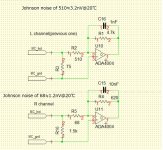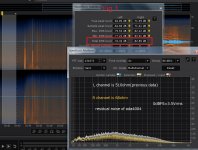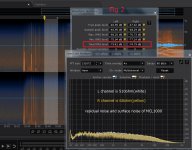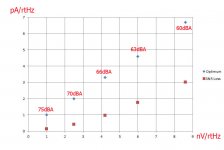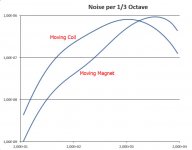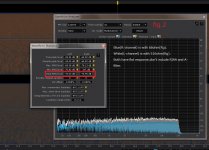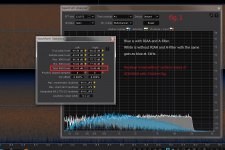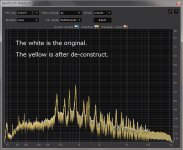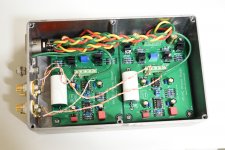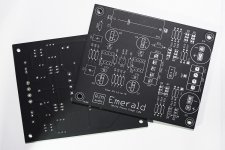What I gather from xx3stksm's post: when you only care about the noise with a record playing and your record's surface noise is similar to xx3stksm's new 180 gram record:
With a 0.3 mV (presumably at 5 cm/s) MC cartridge, 1.8 nV/sqrt(Hz) gives about 3 dB(A) degradation of the signal to noise ratio.
Hence, if you want to keep the degradation below 1 dB(A), your amplifier noise needs to stay below about 0.9 nV/sqrt(Hz) with a 0.3 mV cartridge.
For a 5 mV at 5 cm/s MM cartridge, that would be 15 nV/sqrt(Hz) for 1 dB(A) degradation.
Assuming a 12 kohm effective impedance (500 mH self inductance) for the MM cartridge, 1.25 pA/sqrt(Hz) would also result in a 1 dB(A) degradation.
Back on topic: if you can find an op-amp with less than 0.9 nV/sqrt(Hz) and 1.25 pA/sqrt(Hz) of equivalent input noise and plug it into rjm's circuit, the degradation is at most 1 dB(A) while xx3stksm's record is playing, assuming that the op-amp is the main noise source in the amplifier. If you allow 3 dB(A) of loss, 1.8 nV/sqrt(Hz) and 2.5 pA/sqrt(Hz) will suffice.
With a 0.3 mV (presumably at 5 cm/s) MC cartridge, 1.8 nV/sqrt(Hz) gives about 3 dB(A) degradation of the signal to noise ratio.
Hence, if you want to keep the degradation below 1 dB(A), your amplifier noise needs to stay below about 0.9 nV/sqrt(Hz) with a 0.3 mV cartridge.
For a 5 mV at 5 cm/s MM cartridge, that would be 15 nV/sqrt(Hz) for 1 dB(A) degradation.
Assuming a 12 kohm effective impedance (500 mH self inductance) for the MM cartridge, 1.25 pA/sqrt(Hz) would also result in a 1 dB(A) degradation.
Back on topic: if you can find an op-amp with less than 0.9 nV/sqrt(Hz) and 1.25 pA/sqrt(Hz) of equivalent input noise and plug it into rjm's circuit, the degradation is at most 1 dB(A) while xx3stksm's record is playing, assuming that the op-amp is the main noise source in the amplifier. If you allow 3 dB(A) of loss, 1.8 nV/sqrt(Hz) and 2.5 pA/sqrt(Hz) will suffice.
This is a little bit off the thread. I was under the impression that I used a small value resistor for MC head amplifier and could neglect Johnson noise. But in fact, it's not true like the attached. The Rg(R2) of the previous post is 510ohm(3.2nV) which makes unneglectable noise. I replaced the Rg of R channel with 68ohm(1.2nV). Now, L and R have the same gain and input impedance with different noise power.
The result is Fig 1 and Fig 2. Vinyl is another 180g which is better than before by 1dB(L channel). R channel with 68ohm is better than L channel(510ohm) by 6dB when measured only in residual noise. Fig 2 is residual noise and surface noise. It luckily happens to prove post #41 by MarcelvdG.
I made a simple calculation about input Referred Noise of ADA4004 on the condition where it comes from voltage noise of ADA4004 and Johnson noise by Rg(R2 and R5). The total gain to the input is 76+67-2=141dB. 67 is the gain of the amplifier. 2 is compensation of A-filter(2 is usually for a DAC. Vinyl may have another value). From the 0 dB value of 3.5Vrms, you can get about 310nVrms. But I think another compensation is needed for input Referred Noise because of RIAA.
I estimated the value as 0.57. I calculated the square root sum of RIAA from 100Hz to 20kHz by 100Hz step(200 points). If it has no frequency response, the value is 1, no need to compensate. It becomes below 1 because RIAA suppresses high frequency. I don't have enough confidence about 0.57 but anyway use the value.
The input Referred Noise of 510ohm is 540nV, and those of 68ohm is 270nV.This means 3.8nV/sqrtHz and 1.9nV/sqrtHz in 20kHz bandwidth.
The conclusion is below.
3.8*3.8=3.2*3.2+2*2 where Rg is 510ohm
3.8nV comes from 3.2nV of Johnson and 2nV of ADA4004(1.8nV).
1.9*1.9=1.2*1.2+1.5*1.5 where Rg is 68ohm
1.9nV comes from 1.2nV of Johnson and 1.5nV of ADA4004(1.8nV).
I'm not sure the compensation value 0.57 is correct. I need to measure the value on a real circuit. But the conclusion does not require an imaginary number for the equation. It apparently looks fine.
The result is Fig 1 and Fig 2. Vinyl is another 180g which is better than before by 1dB(L channel). R channel with 68ohm is better than L channel(510ohm) by 6dB when measured only in residual noise. Fig 2 is residual noise and surface noise. It luckily happens to prove post #41 by MarcelvdG.
I made a simple calculation about input Referred Noise of ADA4004 on the condition where it comes from voltage noise of ADA4004 and Johnson noise by Rg(R2 and R5). The total gain to the input is 76+67-2=141dB. 67 is the gain of the amplifier. 2 is compensation of A-filter(2 is usually for a DAC. Vinyl may have another value). From the 0 dB value of 3.5Vrms, you can get about 310nVrms. But I think another compensation is needed for input Referred Noise because of RIAA.
I estimated the value as 0.57. I calculated the square root sum of RIAA from 100Hz to 20kHz by 100Hz step(200 points). If it has no frequency response, the value is 1, no need to compensate. It becomes below 1 because RIAA suppresses high frequency. I don't have enough confidence about 0.57 but anyway use the value.
The input Referred Noise of 510ohm is 540nV, and those of 68ohm is 270nV.This means 3.8nV/sqrtHz and 1.9nV/sqrtHz in 20kHz bandwidth.
The conclusion is below.
3.8*3.8=3.2*3.2+2*2 where Rg is 510ohm
3.8nV comes from 3.2nV of Johnson and 2nV of ADA4004(1.8nV).
1.9*1.9=1.2*1.2+1.5*1.5 where Rg is 68ohm
1.9nV comes from 1.2nV of Johnson and 1.5nV of ADA4004(1.8nV).
I'm not sure the compensation value 0.57 is correct. I need to measure the value on a real circuit. But the conclusion does not require an imaginary number for the equation. It apparently looks fine.
Attachments
I think we are in need of a new thread to discuss the correct way of measuring this stuff and reminders that vinyl 0dB and digital 0dBFS are up to 20dB apart as a useful aide memoir and to stop polluting RJMs thread which now has a signal to noise of just a few dB
It was a little bit surprising thing for me that an analog and digital system didn't have the same standard about SNR. Someone says an analog system has enough headroom above 0dBFS. That's why vinyl is superior to CD. It makes sense to some extent. AFAIK, analog people don't like a digital analysis like FFT. The digital line forum is a suitable place to make a thread about SNR of an analog and digital system.
It's not really suprising when you think about it as FS on digital is a hard stop so you have to work back from that. With tape and vinyl you can push into the red a bit. If you look at say the THX specs , then 85dBA is -20dBFS which is close to the 0dB level for vinyl.
Where it really can confuse is overload margins as you have both RIAA to worry about.
Where it really can confuse is overload margins as you have both RIAA to worry about.
That explains why I roughly calculated -64dBA in posting #35, instead of -60dBA, with the remark that -64dBA was still a bit too optimistic.This is a little bit off the thread. I was under the impression that I used a small value resistor for MC head amplifier and could neglect Johnson noise. But in fact, it's not true like the attached. The Rg(R2) of the previous post is 510ohm(3.2nV) which makes unneglectable noise. I replaced the Rg of R channel with 68ohm(1.2nV). Now, L and R have the same gain and input impedance with different noise power.
But going from 68 to 510 Ohm decreases the SNR by 4.1dBA, bringing my calculation exactly to -60dBA.
And Bill, hoping not to upset you, this standard of ca -60dBA is very relevant also in this thread as a reference.
It is up to the Amateur to better this figure by 0, 3, 10 dB or whatever he wishes to achieve, but without a reference you are completely left in the dark for what you should aim at.
Hans
OK, with 4.1 dB more surface noise, all values increase by 60 %:
With a 0.3 mV (presumably at 5 cm/s) MC cartridge, 2.88 nV/sqrt(Hz) gives about 3 dB(A) degradation of the signal to noise ratio.
Hence, if you want to keep the degradation below 1 dB(A), your amplifier noise needs to stay below about 1.44 nV/sqrt(Hz) with a 0.3 mV cartridge.
For a 5 mV at 5 cm/s MM cartridge, that would be 24 nV/sqrt(Hz) for 1 dB(A) degradation.
Assuming a 12 kohm effective impedance (500 mH self inductance) for the MM cartridge, 2 pA/sqrt(Hz) would also result in a 1 dB(A) degradation.
If you can find an op-amp with less than 1.44 nV/sqrt(Hz) and 2 pA/sqrt(Hz) of equivalent input noise and plug it into rjm's circuit, the degradation is at most 1 dB(A) while xx3stksm's new record is playing, assuming that the op-amp is the main noise source in the amplifier. If you allow 3 dB(A) of loss, 2.88 nV/sqrt(Hz) and 4 pA/sqrt(Hz) will suffice.
I always thought that using one single input stage for MM and MC is silly unless it is a really high transconductance JFET input stage, but this shows clearly that I was wrong, at least when you only care about the noise while a record is playing. You can easily stay below 1.44 nV/sqrt(Hz) and 2 pA/sqrt(Hz) with a bipolar input stage.
Another interesting conclusion is that this basically boils down to noise-optimizing the combined MC/MM amplifier for Smc/Smm * Zmm, where Smc and Smm stand for the sensitivity of the moving coil and moving magnet cartridge, respectively (*), and Zmm stands for the effective impedance of the moving-magnet cartridge. The impedance of the moving-coil cartridge is not in the equation because I've neglected it. In the given example, Smc/Smm * Zmm = 720 ohm.
(*): I have no idea what the usual symbol for the sensitivity of a cartridge is.
With a 0.3 mV (presumably at 5 cm/s) MC cartridge, 2.88 nV/sqrt(Hz) gives about 3 dB(A) degradation of the signal to noise ratio.
Hence, if you want to keep the degradation below 1 dB(A), your amplifier noise needs to stay below about 1.44 nV/sqrt(Hz) with a 0.3 mV cartridge.
For a 5 mV at 5 cm/s MM cartridge, that would be 24 nV/sqrt(Hz) for 1 dB(A) degradation.
Assuming a 12 kohm effective impedance (500 mH self inductance) for the MM cartridge, 2 pA/sqrt(Hz) would also result in a 1 dB(A) degradation.
If you can find an op-amp with less than 1.44 nV/sqrt(Hz) and 2 pA/sqrt(Hz) of equivalent input noise and plug it into rjm's circuit, the degradation is at most 1 dB(A) while xx3stksm's new record is playing, assuming that the op-amp is the main noise source in the amplifier. If you allow 3 dB(A) of loss, 2.88 nV/sqrt(Hz) and 4 pA/sqrt(Hz) will suffice.
I always thought that using one single input stage for MM and MC is silly unless it is a really high transconductance JFET input stage, but this shows clearly that I was wrong, at least when you only care about the noise while a record is playing. You can easily stay below 1.44 nV/sqrt(Hz) and 2 pA/sqrt(Hz) with a bipolar input stage.
Another interesting conclusion is that this basically boils down to noise-optimizing the combined MC/MM amplifier for Smc/Smm * Zmm, where Smc and Smm stand for the sensitivity of the moving coil and moving magnet cartridge, respectively (*), and Zmm stands for the effective impedance of the moving-magnet cartridge. The impedance of the moving-coil cartridge is not in the equation because I've neglected it. In the given example, Smc/Smm * Zmm = 720 ohm.
(*): I have no idea what the usual symbol for the sensitivity of a cartridge is.
A small contribution to visualise things a bit clearer, specifically for the design in this thread.
In the image below, I have visualised what Op-Amp specs will have to be used when accepting a certain noise contribution from the Phono stage to the surface noise from the platter.
I have made a number of not too stringent assumptions.
For the MM, L=600mH and Rcart=800Ohm, Rin=47K, Cin=125pF
Sensitivity is 5mV@5cm/sec/@1KHz
For the MC, Rcart=30Ohm and Rfb=50Ohm, where Rfb represents the equivalent noise value of the resistors around the input Op-Amp.
Sensitivity is 0.5mV@5cm/sec@1KHz
SNR ref 1KHz@0dB from an LP is 60dBA
The five points in the image are from L to R resp. for a Phono stage with a SNR of resp 75, 70, 66, 63 and 60dBA, in all cases giving the same SNR for MM and MC.
As an example: when allowing for a Phono stage giving 1dB SNR Loss to the 60dBA from the LP, an Op-Amp having 4.2nV/rtHZ and 3.3pA/rtHz should be selected.
In that case, the Phono stage will have a SNR of 66dBA for MC and for MM.
In the image below, I have visualised what Op-Amp specs will have to be used when accepting a certain noise contribution from the Phono stage to the surface noise from the platter.
I have made a number of not too stringent assumptions.
For the MM, L=600mH and Rcart=800Ohm, Rin=47K, Cin=125pF
Sensitivity is 5mV@5cm/sec/@1KHz
For the MC, Rcart=30Ohm and Rfb=50Ohm, where Rfb represents the equivalent noise value of the resistors around the input Op-Amp.
Sensitivity is 0.5mV@5cm/sec@1KHz
SNR ref 1KHz@0dB from an LP is 60dBA
The five points in the image are from L to R resp. for a Phono stage with a SNR of resp 75, 70, 66, 63 and 60dBA, in all cases giving the same SNR for MM and MC.
As an example: when allowing for a Phono stage giving 1dB SNR Loss to the 60dBA from the LP, an Op-Amp having 4.2nV/rtHZ and 3.3pA/rtHz should be selected.
In that case, the Phono stage will have a SNR of 66dBA for MC and for MM.
Attachments
This doesn't seem to match xx3stksm's measurements, also not after correcting his 4.1 dB mistake and the difference in MC cartridge sensitivity:
10^(4.1/20)*1.8 nV/sqrt(Hz) gives about 3 dB degradation with a 0.3 mV at 5 cm/s cartridge
Hence, (0.5/0.3)*10^(4.1/20)*1.8 nV/sqrt(Hz) ~= 4.81 nV/sqrt(Hz) should result in a degradation of about 3 dB with a 0.5 mV at 5 cm/s cartridge.
Yet you find only 1 dB degradation with 4.2 nV/sqrt(Hz)?
10^(4.1/20)*1.8 nV/sqrt(Hz) gives about 3 dB degradation with a 0.3 mV at 5 cm/s cartridge
Hence, (0.5/0.3)*10^(4.1/20)*1.8 nV/sqrt(Hz) ~= 4.81 nV/sqrt(Hz) should result in a degradation of about 3 dB with a 0.5 mV at 5 cm/s cartridge.
Yet you find only 1 dB degradation with 4.2 nV/sqrt(Hz)?
I am a bit confused by your figures, but let me recollect.This doesn't seem to match xx3stksm's measurements, also not after correcting his 4.1 dB mistake and the difference in MC cartridge sensitivity:
10^(4.1/20)*1.8 nV/sqrt(Hz) gives about 3 dB degradation with a 0.3 mV at 5 cm/s cartridge
Hence, (0.5/0.3)*10^(4.1/20)*1.8 nV/sqrt(Hz) ~= 4.81 nV/sqrt(Hz) should result in a degradation of about 3 dB with a 0.5 mV at 5 cm/s cartridge.
Yet you find only 1 dB degradation with 4.2 nV/sqrt(Hz)?
The MC-L1000 has an output of 0.22mV@5cm/sec/1Khz.
SNR of the ADA4004 preamp with a 30 Ohm cart and an Rfb of 68Ohm / 510Ohm ref 0.22mV is resp 64.9dBA and 60.8dBA.
SNR of a 4.2nV/rtHz Op-Amp with a 30Ohm cart and an Rfb of 50Ohm ref 0.5mV is 66dBA.
This 66dBA Phono stage noise combined with 60dBA LP noise results in a SNR Loss of 1.0dB.
Hans
Posting 45 mentioned that going from 68 Ohm to 510 Ohm resulted in a SNR Loss of 4.1 dB.Now I'm confused; where does that 4.1 dB in post 45 come from?
In posting 50 the accompanying SNR figures were given, being resp. 64.9 and 60.8 dBA.
Hans
In posting 50, SNR for a certain point with specified nV/rtHz and pA/rtHz is made the same for the MM and MC setting.
However dBA is just one cumulated figure of all A-Weighted noise and tells nothing about the nature of the noise.
That's why I have included the image below, to show the spectra of the noise for MM and MC, in both cases for 66dBA, ref 5mV and 0.5mV resp.
So the area under the curves is the same (the MC amplitude has been multiplied by a factor 10) but the curves are rather different.
Peak in frequency for MC lies at 2 KHz and for MM at 6.5 KHz.
The noise from an MM will therefore sound more like a hiss.
So far the differences in noise production between both.
Hans
However dBA is just one cumulated figure of all A-Weighted noise and tells nothing about the nature of the noise.
That's why I have included the image below, to show the spectra of the noise for MM and MC, in both cases for 66dBA, ref 5mV and 0.5mV resp.
So the area under the curves is the same (the MC amplitude has been multiplied by a factor 10) but the curves are rather different.
Peak in frequency for MC lies at 2 KHz and for MM at 6.5 KHz.
The noise from an MM will therefore sound more like a hiss.
So far the differences in noise production between both.
Hans
Attachments
the measured data
I measured real noise power of ADA4004. My post #42 used estimated data for RIAA compensation(0.57=5dB). My SIM was 7dB because of 2dB for A-filter and 5dB for RIAA. That was almost correct like fig.1. The true value is 6.4dB(76.8-70.4=6.4). The more precise input Referred Noise of ADA4004 is below.
3.6nV/sqrtHz with 510ohm(Rg) under 20kHz bandwidth
This may be from 3.2nV of Johnson and 1.6nV of ADA4004 because 3.6*3.6=3.2*3.2+1.6*1.6.
1.8nV/sqrtHz with 68ohm(Rg) under 20kHz bandwidth
This may be from 1.2nV of Johnson and 1.0nV of ADA4004 because 1.8*1.8=1.2*1.2+1.0*1.0.
The difference between 510ohm and 68ohm is 6.5dB like fig.2.
ADA4004 has 1.8nV(typical value) residual noise. It may be a little bit high performance to have 1.0nV with 68ohm. But I'm sure this is correct. Because this is calculated by three parameters, FS of the ADC, noise power and the gain of the amplifier. I measured them and calculated the value. If you can use the measured value of 0.5nV opamp with 68ohm, you can get 1.3nV residual noise(1.3*1.3=1.2*1.2+0.5*0.5). This can be probably available but over performance for vinyl recording, IMHO.
I measured real noise power of ADA4004. My post #42 used estimated data for RIAA compensation(0.57=5dB). My SIM was 7dB because of 2dB for A-filter and 5dB for RIAA. That was almost correct like fig.1. The true value is 6.4dB(76.8-70.4=6.4). The more precise input Referred Noise of ADA4004 is below.
3.6nV/sqrtHz with 510ohm(Rg) under 20kHz bandwidth
This may be from 3.2nV of Johnson and 1.6nV of ADA4004 because 3.6*3.6=3.2*3.2+1.6*1.6.
1.8nV/sqrtHz with 68ohm(Rg) under 20kHz bandwidth
This may be from 1.2nV of Johnson and 1.0nV of ADA4004 because 1.8*1.8=1.2*1.2+1.0*1.0.
The difference between 510ohm and 68ohm is 6.5dB like fig.2.
ADA4004 has 1.8nV(typical value) residual noise. It may be a little bit high performance to have 1.0nV with 68ohm. But I'm sure this is correct. Because this is calculated by three parameters, FS of the ADC, noise power and the gain of the amplifier. I measured them and calculated the value. If you can use the measured value of 0.5nV opamp with 68ohm, you can get 1.3nV residual noise(1.3*1.3=1.2*1.2+0.5*0.5). This can be probably available but over performance for vinyl recording, IMHO.
Attachments
I measured real noise power of ADA4004. My post #42 used estimated data for RIAA compensation(0.57=5dB). My SIM was 7dB because of 2dB for A-filter and 5dB for RIAA. That was almost correct like fig.1. The true value is 6.4dB(76.8-70.4=6.4). The more precise input Referred Noise of ADA4004 is below.
3.6nV/sqrtHz with 510ohm(Rg) under 20kHz bandwidth
This may be from 3.2nV of Johnson and 1.6nV of ADA4004 because 3.6*3.6=3.2*3.2+1.6*1.6.
1.8nV/sqrtHz with 68ohm(Rg) under 20kHz bandwidth
This may be from 1.2nV of Johnson and 1.0nV of ADA4004 because 1.8*1.8=1.2*1.2+1.0*1.0.
The difference between 510ohm and 68ohm is 6.5dB like fig.2.
ADA4004 has 1.8nV(typical value) residual noise. It may be a little bit high performance to have 1.0nV with 68ohm. But I'm sure this is correct. Because this is calculated by three parameters, FS of the ADC, noise power and the gain of the amplifier. I measured them and calculated the value. If you can use the measured value of 0.5nV opamp with 68ohm, you can get 1.3nV residual noise(1.3*1.3=1.2*1.2+0.5*0.5). This can be probably available but over performance for vinyl recording, IMHO.
Datasheet under
http://www.analog.com/media/en/technical-documentation/data-sheets/ADA4004-1_4004-2_4004-4.pdf
don't show the internal schematic.
Where I can find it (at least a simplified version to understand the theory of operation) ?
concerning residual noise check post #7 under
Reducing Record Surface Noise - I want to know all Approaches
Last edited:
concerning residual noise check post #7 under
Reducing Record Surface Noise - I want to know all Approaches
...which refers to a website of someone who basically re-invented the DNL system Philips used to build into cassette players: a low-pass filter that automatically reduces its cut-off frequency when the signal is weak.
If you want an effective method to reduce the surface noise of vinyl, The best way, as far as I have experienced, is digital processing, for example, iZotope RX4 like attached. The first generation of noise reducing(de-noise) had not sufficient performance like the first generation of a CD player. Bad reputation still exists and is making digital processing phobia.
So is me before I know the second generation(de-construct).
De-noise is effective only in small amplitude while de-construct can process both large signal and a small one. It probably deconstructs the input into signal and noise. Then It reduces only noise spectrum before It reconstructs the original. That's why signal spectrum is almost same while noise spectrum is less than 6dB before processing.
Surface noise to human perception deeply depends on frequency. As far as I have experienced, from 1kHz to 8kHz is the most important. If you decrease this by 3dB, you can feel enough improvement. If you get a 6dB decrease, you can feel surface noise has almost gone. De-construct can decrease noise spectrum only without unexpected sonic side effect. I'm very satisfied with this. The disadvantage is cost. RX4 with de-construct is a little bit expensive.
So is me before I know the second generation(de-construct).
De-noise is effective only in small amplitude while de-construct can process both large signal and a small one. It probably deconstructs the input into signal and noise. Then It reduces only noise spectrum before It reconstructs the original. That's why signal spectrum is almost same while noise spectrum is less than 6dB before processing.
Surface noise to human perception deeply depends on frequency. As far as I have experienced, from 1kHz to 8kHz is the most important. If you decrease this by 3dB, you can feel enough improvement. If you get a 6dB decrease, you can feel surface noise has almost gone. De-construct can decrease noise spectrum only without unexpected sonic side effect. I'm very satisfied with this. The disadvantage is cost. RX4 with de-construct is a little bit expensive.
Attachments
Attachments
- Status
- This old topic is closed. If you want to reopen this topic, contact a moderator using the "Report Post" button.
- Home
- Source & Line
- Analogue Source
- an mm/mc phono stage
